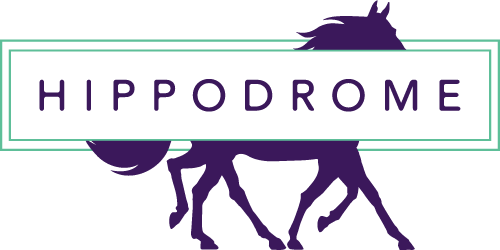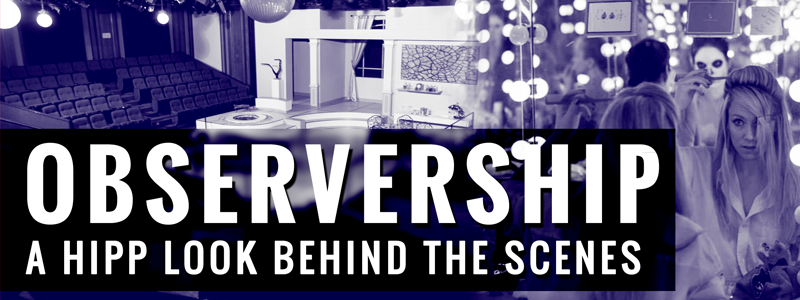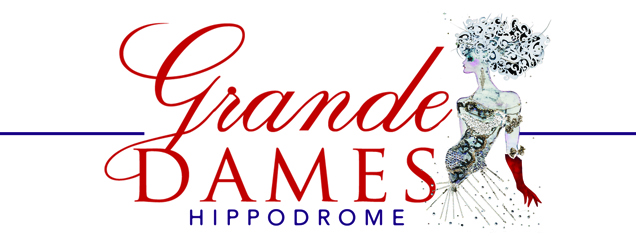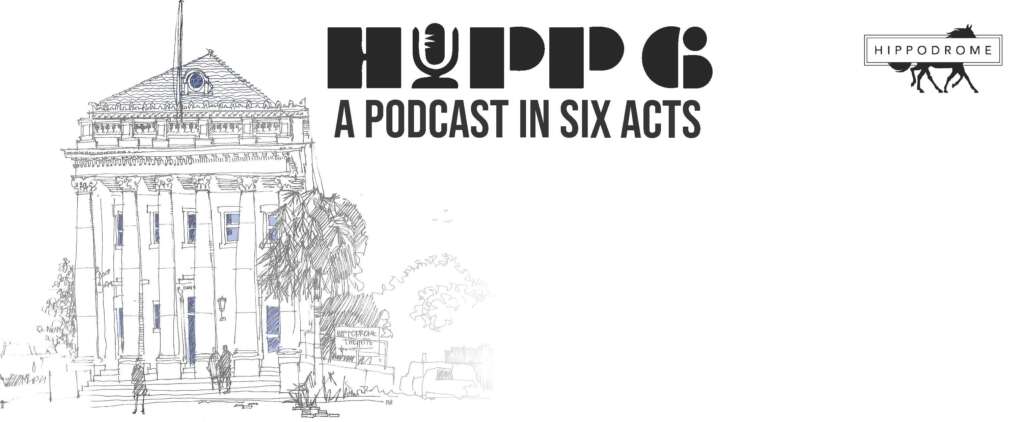
Funding for this podcast was provided by a grant from the Florida Humanities with funds from the National Endowment for the Humanities. Any views findings, conclusions, or recommendations expressed in this podcast do not necessarily represent those of Florida Humanities or the National Endowment for the Humanities.
Act 2
With the help of Hippodrome founder Bruce Cornwell, this episode recounts the behind-the-scenes tales from the early days of the Hippodrome and tells the story of a show that put the Hippodrome on the map: Equus.
Lauren Cox 00:02
Are there any kind of like, especially in the other buildings before you got to the old post office building? Do you remember any kind of like stories or memories that particularly stick out in the older the previous Hippodromes?
Bruce Cornwell 00:15
Do you have a week for us to talk? We were doing a production of a play called Gemini by Albert Innaurato. At the second Hippodrome, this is out on 441 at the warehouse, and Marshall was playing an adolescent, I guess, sort of like a late teenage boy, but maybe even, maybe even a bit older, but who was kind of stunted, except that he was very overweight. And Marilyn had created a padded costume like fat padding for him to wear, in order to get the girth, that his character really needed to have for the, for the purposes of the play. We had a two story set. The roof at that warehouse, Hippodrome was much higher, and so it was possible to build, you know, buildings that were two stories, and the play was set in Philadelphia tenements in in South Philly, and it was sort of like in the backyard, but it was where all of these different buildings came together just to form a little backyard or courtyard. Anyway, it’s a coming of age story of this, of this teenage boy who’s getting ready to go off to college having a birthday and all the families are coming together, and he’s struggling with his background and all sorts of stuff. And anyway, Marshall, at one point, had this scene where he leaves one part of the set, runs backstage, and had to climb the stairs to appear in the bedroom window of the bedroom that’s up on the second floor of one of the tenement buildings. And he’s racing up the stairs and he trips. And we had created the walls were all these exterior brick, these are all brick tenements, right, and we had created the brick walls out of styrofoam that was probably like maybe an inch thick, maybe an inch and a half thick styrofoam, and we had like, actually created the outlines of bricks and painted them and painted the mortar and they were very realistic looking as far as looking like exterior walls or brick tenements. Anyway, Marshall tripped, and all of a sudden, he comes flying through one of brick walls, and styrofoam goes spraying out all over the audience. And he’s sitting there, you know, face first, he’s just looking at the audience. And it was like, oh, my God, how do we recover this one. So anyway, just one of those moments.
Gregory von Hausch 02:53
Speaking of the old warehouse, we had a production of Sly Fox that we took on the road. And when we came back, we were doing it again, a revival of it. In the play it’s set in like 1880s San Francisco. It was adapted from Volpone, which is an old Renaissance comedy. In the play, the updated play is more like the old west. So there’s a courtroom scene where I’m on trial for this elaborate spoof we did on all these actors, on all these characters in the play. And the judge was kind of hanging judge. He has this gun that he fires in the courtroom all the time, and we used to make our own blanks. We put the gunpowder in and put the wadding in it. We made our own blanks to save money because over the course of a long run, the ammo was, you know, especially when we were doing two shows a day, to add up in cost. And the guy playing my lawyer was Greg Jones, who was a great actor. He was in a lot of our stuff. And Mike Feister was playing the judge, also really funny, funny actor. He would fire this gun off into the ceiling. He would aim it at people and shoot. When my lawyer Greg Jones made an objection during one night, he fired the gun right at him, and this wadding was propelled across the stage, and hit Greg right above the eyebrow, and his head just burst open and blood went everywhere. He looks ahead with this scared look. I’m looking at him. And he says, is it bad. I said, no, it’s not bad, and it was horrible. And I pull out a handkerchief and he had another one and I gave it to him and I’m blotting the blood and we’re trying to hold it. We go through the rest of the act until the scene is over, and there’s blood just everywhere gushing out the stage. And Greg was a real trooper about that and being able to carry on. Another night in the same play with the gun. He knows now not to shoot it into the, toward anybody, you know. So when he fires it into the ceiling, above the grid, the ceiling was padded, we baffled it with all this matted material. And we had our work lights up there which were long, eight foot long, fluorescent tubes. Mike fires the gun off into the ceiling, and it bursts one of the fluorescent lights and rains down onto the stage and onto the seating platforms where people are seated. And it’s just a nightmare of glass and everything and we had to hold the audience to hold the play then, sweep it up, and all of that. That was, that was another kind of debacle. The audience was very, I already told you about the rain check that we used to have to have with the rain. So they were used to things happening at that space. So that went off without a hitch after we cleaned up.
Ryan George 07:08
The Hippodrome has had many of those kinds of moments in it’s nearly 50 years in existence. That’s Hippodrome founders, Bruce Cornwell and Gregory Vaughan house, sharing some of the behind the scenes moments from the early days of the hip. The hip began when six artists Bruce Cornwell, Gregory von Hausch, Mary Hausch, Kerry Oliver Smith, Marylinn Wall, and Orin Wechsberg struck out on their own to create a new theater in Gainesville, Florida. This is the Hipp Six, a podcast about the early days of the Hippodrome theatre. I’m your host, Ryan George, a graduate of UF School of Theatre and Dance currently living in New York City. My journey with the Hipp began back in 2010, when I was cast in Defiance during my last semester at school. Through my experience with the Hippodrome, I’ve gone from cast member, to company member, to also a director. In our last episode, we told you about how the Hippodrome started out in a building out on Hawthorne Road, and then to a warehouse out on 441 before finally calling the old post office building downtown home. In this episode, we’re going to fill you in on some of those Hippodrome moments, and also tell you about a show that put the Hippodrome on the map: Equus. Let me also introduce my podcast colleague, Lauren Burrell Cox, Lauren’s a film PhD candidate at UF. The podcast project started when Lauren began collecting the Hippodrome oral histories. She’ll be helping me tell some of these stories. Act Two A Funny Thing Happened on the Way to the Hippodrome with Bruce Cornwell.
Lauren Cox 09:05
I started this project in the summer of 2020, while I was doing a remote internship with the Hippodrome before the pandemic. The internship was supposed to focus on archiving. I’m completing my PhD in film at the University of Florida, and I’m writing a dissertation about archival film. I’ve always been interested in what gets preserved and why, central questions for people who study archives. While I originally thought that I’d be working in already established archive of the Hipp, 2020 changed everyone’s plans. With archiving in person at the Hipp no longer an option, I discussed with Gabrielle Byam, my internship supervisor and the Director of Education at the Hipp, other projects that I could create. This is where the idea for collecting the oral histories of the Hippodrome started. Instead of working in an already established archive, I got to begin creating one. One of my goals going into the project was to document the stories that wouldn’t make it into the history books. With oral histories, you can find those smaller stories that people have. Stories that give texture, warmth, and spirit to a place. I wanted to hear the stories that were memorable to capture those small anecdotes that illustrated the moments that made working at the Hippodrome fun, special, and sometimes maybe even outrageous. This episode represents a collection of those. But of course, it’s impossible to document them all. Another issue of the archive. Bruce first started with the Hippodrome while he was working on his master’s degree at UF.
Bruce Cornwell 10:44
Well, the six of us who were the founders were all theater students with the University of Florida. We were all members of the Florida players. Actually, I’m not sure about a couple of them may have been in peripheral or, you know, other majors in college. But we were all together, working on shows. And there were four of us that were sharing a little tiny house in Gainesville, fairly close to the university and in a neighborhood that used to be known as the student ghetto.
Lauren Cox 11:19
This first Hippodrome was out on Hawthorne road and a storefront. And some members have referred to it as an old 711.
Bruce Cornwell 11:26
That was a wonderful building because we had studied a concept in theater called environmental theater where the entire environment, the room gets changed completely from one show to the next, rather than simply building a set in front of the audience. So we would change the environment of that room for every show.
Marshall New 11:51
It was theater, like I’d never experienced before it was environmental, like in Steam Bath, the audience sat in the steam bath, with the actors, as the play took place in front of them almost in their laps sometimes. And in Macbeth, it was doom and gloom, all filling the entire renovated 7/11 store out on the outskirts of Gainesville, out toward Lake, whatever that lake is called. The Hippodrome was on the edge of town in this converted 7/11. The store itself had been gutted and was just created the space for the theater itself. So I don’t think it sat more than 50 people.
Lauren Cox 12:43
That’s Marshall New. Marshall was an early member of the Hippodrome and we’re gonna save his official introduction for another episode. But trust me, the way he got to the Hippodrome is really good.
Bruce Cornwell 12:57
The first show was actually quite funny, because Greg was directing a production of Neil Simon’s The Odd Couple. And one of the members of the group was really into avant garde theater, and thought it would be fun to to create the entire space with black visqueen and black drapes and just have it and this is, you know, this is a romantic, you know, a silly comedy from from Neil Simon. I walked in one day, and Greg looked like, he was pretty depressed. And I said, What’s wrong, you know? And he said, Oh, God, this idea of doing Neil Simon’s The Odd Couple in, in black visqueen in a black void, just doesn’t work. It doesn’t cut it. What do we do? What do we do? And I, you know, together we said, All right, let’s, let’s get busy here, we need to build a set and create a, you know, a set that would be appropriate for Neil Simon’s The Odd Couple. And we did, we just went, we just went berserk and started building and painting and putting up these putting flats out to create the walls and the rooms and furniture and everything. And, and so as it turned out, it worked beautifully. I mean, the set was very appropriate. And then, strangely enough, the next show we did the second show, was a Eugene Ionesco show, you know, a black void was perfectly appropriate for that show. So then, Orin got to have his black visqueen as the as the set design as it turned out.
Lauren Cox 14:26
The founders dedicated themselves to the theater. They were there all the time. And everyone worked in all the different roles necessary for putting on a show.
Bruce Cornwell 14:35
So yeah, this the first season had a variety of interesting shows that we had, we had met a gentleman and a writer named Jean-Claude van Itallie, who was a member of the New York open theatre with Joseph Chaikin and they were groundbreaking theatre artists of the time. And and Jean-Claude van Itallie had been invited by the university to do a playwriting workshop. And we all went and attended the workshop and got to know him. And somehow we all hit it off. And we were doing a production of a pretty offbeat, strange play called Pap at the time, which was set in some distant, futuristic Vatican, in which basically everything had crumbled, and it was in ruins. But there was still this guy going around. He didn’t call himself the pope anymore, you know, the language had been distorted, and the building was decayed, and everything was rotted, and he called himself pap. Anyway, Jean-Claude van Itallie, came and saw our production of Pap, and he was he, I guess he was pretty blown away by it, because he got on the phone the next day. And he called the lady who at the time was the was the Director of the National damage theater program, Ruth Mayleas and said, You need to get an auditor down here immediately to see these people what’s going on down here, which was wonderful. And sure enough, within a couple of months, a gentleman by the name of Arthur Balat, who was the who took over eventually, as the next program, Director of theater program came down and, and audited. And then we were given, from that point on, we started receiving grants from the National Endowment theatre program. We were there, Oh, God, we would, we would work these crazy hours putting the shows together. I mean, we would get there at eight or nine in the morning. And then we would work until midnight you know, almost like non stop in order to, in order to get things up and running. Because we were having to build the sets, we were having to write grant proposals, we were having to, you know, do whatever sort of budgeting we needed to do. And we had to rehearse the shows, you know, so, and hang lights and all that kind of stuff. So anyway, one night, Marilynn and I were there at probably about two in the morning, because I had gotten this crazy idea to put a particular treatment that I wanted to create for the floor of the set. And as I said earlier, you know, it wasn’t just the stage set the set meant the entire room. And so we were there, and I was doing all this crazy stuff with painting all of these very impressionistic clouds on the floor, replicating sort of like this springtime summertime sky on the on the stage floor. And at some point, I had this huge oh, it was bigger than a gallon bucket of paint, and I kicked it and it just fell over and just went all over everything. And it was like oh, no, I’m gonna have to start over here. Anyway, it’s just one of one of those silly stories of what happened.
Lauren Cox 18:12
Malcolm Gets an actor and nowUF professor had some of his earliest experiences as a teenager at the Hippodrome.
Malcolm Gets 18:19
While I was never at the 7/11 I came into the 441 and I was there every single day every single night all the time and I ran lights for shows I did sound for shows I filled scenery. We did as you like it, I sang in that and I wrote I said the Shakespeare piece to the minstrel the Shakespeare text to music myself. So I was just I was there all the time.
Lauren Cox 18:46
Bob Robins, the lighting designer, production manager and facility manager for the Hippodrome started working at the Hipp when he was in college. Here he describes the atmosphere of the Hippodrome.
Bob Robbins 18:57
Well, you know, back in those early, heady days, I it was it was just on that main stage, it was just all I mean, it was hard work. But it was also professional and large ideas. And, you know, it’s just everything was just so colorful, and texture. Parties were great. You know, it was it was good, good camaraderie. You know, theater is all about, really about forming families.
Lauren Cox 19:28
The larger Gainesville community recognized the Hippodrome as a serious theatre with its production of Equus in the 1977-78 season, which Bruce directed. Equus is a play written in 1973 by Peter Shaffer. It tells the story of a psychiatrist who attempts to treat a young man who has a pathological, religious fascination with horses. And it had been a hit in New York and London, with actors Anthony Hopkins, Richard Burton, Leonard Nimoy and Anthony Perkins at different times starring in the production, the play again surfaced in pop culture when Daniel Radcliffe, of Harry Potter fame, starred in a revival of the show in 2007. Here’s Bruce explaining more about the Hipp’s production
Bruce Cornwell 20:12
We created a production of Equis, you may have heard of equities by Peter Shaffer, and we toured it, we did a tour throughout the United States. And it was it was really wonderful. I mean, the production was excellent. I’m trying to find a way to say that we, it was so successful that suddenly, we found ourselves with more capital to be able to work with for future productions than we had ever experienced before because it was it was, you know, the most financially successful show that we had done. And so then this, this man either heard about it, he was a producer from down in the Tampa/St. Pete area, and he heard about it came up and saw the production and then talk to us about taking it on tour, and so we did. We created a touring production, because the set that we had put together for the original production was not really designed to tour, but so we we had to modify it and and take it on tour. And we toured it, we toured all over the state and the southeast with that production and it was a wonderful experience for us. It was a lot of fun. Mark Sexton played the boy Alan Strang in that production of Equus, and an actor who worked with us who passed away a number of years ago, Michael Doyle played the psychiatrist Dr. Dysart.
Lauren Cox 21:43
Mark Sexton is now the communications and Legislative Affairs Director for Alachua County in Gainesville.
Marshall New 21:50
I think it was after we did Equus, that the Hippodrome was kind of kicked itself up to a different level of production. Because it wasn’t just a production put on by a bunch of people who like to act and direct. It was a serious attempt to recreate a play that had been done successfully in New York and London.
Bruce Cornwell 22:16
So it was kind of like an avant garde time and a time of some turmoil, but also a lot of progressive thinking around the arts. And I mentioned that right now in the context of Equus, because the play requires nudity. And so there’s a you know, there’s a scene in the play, where both the boy Alan Strang and his girlfriend who works in the stables in in Britain, the play takes place in Great Britain, and he works with the family that owns the stables. And of course, the play is all about him having psychiatric problems and eventually blinding the horses. But there is a scene that takes place in the play in which both the he and the girl that is working in the stables with him are disrobed in the play on stage. And so that was controversial because I don’t know that that had ever happened before in Gainesville. And people were stunned and, and also turning out in droves to see the show. But, but I want to say that that was not the calling card of the show. Actually, the production values were really wonderful. Very interesting, because boy, the times they have changed, haven’t they? You know, like, I can’t imagine nudity onstage in Gainesville today in the current climate, you know.
Lauren Cox 23:49
I’m not really sure how we’ll show like Equus would go over now in Gainesville. And reading through the Independent Florida Alligator archives, the University of Florida student newspaper, I came across an article that discussed a proposed nudity ban in Gainesville in the 70s. One of the arguments of the article presented against the nudity ban was that arts institutions like the Hippodrome would be censored and they wouldn’t be able to put on shows like Equus.
Marshall New 24:18
Well, we had plenty of nudity before that. Tom Jones had a lot of nudity in it. Male nudity as well as female, and Macbeth had a lot of nudity in it with a lesbian version of Macbeth. Because of a scene where Lady Macbeth does the out damn spot speech, and to witches, scantily clothed witches, did a undulating love dance with each other while she’s reciting that monologue. Marat-Sade had a lot of very, you know, it takes place in an insane asylum. So it was crazy nudity. You know, and when I’m saying crazy nudity, I mean, insane nudity. But anyway, we, we were daring in this, in this capacity and we didn’t ever hesitate to, to include nudity, profanity, and the things that you, you know, the Baptist Church didn’t support in Gainesville, that’s for sure. So that was a big year. Equus was a play that did not feature any Hippodrome founders or you know, company members in the play. Bruce directed it. We all produced it, because we had, there was a lot of pressure to do it in a way that it hadn’t been done on Broadway. We did it with a revolving stage. And we staged, refigured the warehouse, instead that the play would be in the round, trying to create a sense of Greek amphitheater, because the play has a lot of allusions to the ancient Greeks. And, you know, there’s just a lot of allusions to this story of the fight between man and beast in the eternal fight, internal, not eternal, but internal fight between man and beast. It was a very successful play. And it had a young actor Mark Sexton, who play the boy and the and the young woman who played the stable girl who seduces him. In that moment, in the play, it was sort of like you were seeing, it was like watching Adam and Eve. And Mike Doyle played the psychotherapist. And it was just a well written, very successful staging that, again, was environmental to emphasize aspects of the play. It kicked the Hippodrome up a notch in terms of getting attention in the community. huge success in terms of box office. In fact, I think we raised the prices from $3 to $5 for tickets then.
Lauren Cox 27:34
The Hipp continued on its streak of shows that gained attention outside of the Gainesville community
Marshall New 27:41
Now plays that came after the Elephant Man from 80 to 84 were fraught with economic distress. we were still trying to be as adventurous and exciting theater production company as possible. But it became more and more difficult to because we had jumped up to a level that couldn’t be supported by the meager amount of money we got, not meager, but sale of tickets did not cover the expenses of running the theater in the old post office. And thank God we got named one of the state theaters in Florida because there was a line item in the budget that allowed us to receive some money that boosted, made it possible, but a lot of the vision that we had for what the Hippodrome in the post office would be kind of crashed after its first year because we were in such dire economic stress.
Gregory von Hausch 29:09
And we were doing a production in Hippodrome to again of ruling class and in ruling class, Chad Reed, who is actor we all went to school with us without so many of our productions and was one of our first Scrooges as well. He plays this English gentleman who is sort of a closet Queen, who committed suicide in the opening act by hanging himself. And that sets up where the lead character, the ruling class now is the heir of this huge estate. So we made this harness for Chad to hang himself, and where he would have it as hard as the rope would go down through his jacket, and it would look like he would be hanging but it would actually be the harness holding them up. And sure enough, one night that harness broke. Chad was literally hanging himself on stage. Throughout the rest of the scene, when the lights go down, we go out and help him get down. Also, the harness, you know, because he’s incapacitated, you know, there’s these feet are dangling. And we go there in a blackout, and he points we realize he’s literally hanging, and you know, all of this stage craft stuff. If you’re on Broadway, there’s people that specialize in making blanks and making flying people and hanging people and stuff like that. But we all did that on our own. So, you know, we thought we had done gotten all the bugs out of the machine, but it didn’t quite work that way. So we’re glad that Chad’s still with us to this day.
Ryan George 31:26
Bruce left the Hippodrome in 1980 and worked as a director in repertory theaters in Milwaukee and Off Broadway in New York City. He became a therapist in the late 1980s in Massachusetts. He acted and directed plays there, and he later moved to LA and worked as an actor in theater, film and television. He is now a licensed clinical worker in a clinic of the Veterans Affairs Medical Center in Gainesville. He’s also now a board member at the Hippodrome. The friendships and camaraderie of the Hippodrome continue to this day, and so do the laughs the old warehouse on 441 contains many memories. And it also had a famous guest. That’s what we’ll tell you about on the next episode of the hip six. The time Tennessee Williams came to Gainesville. Funding for this podcast was provided through a grant from the Florida Humanities with funds from the National Endowment for the Humanities. Any views findings, conclusions or recommendations expressed in this podcast do not necessarily represent those of Florida Humanities or the National Endowment for the Humanities additional support from the Hippodrome and the University of Florida Center for the Humanities and the Public Sphere. It is hosted by Ryan George. It was produced by Gabrielle Byam, Lauren Burrell Cox and Amanda Fraser. It was written and edited by Lauren Burrell Cox Ashe Phoenix designs, Joshua Osborne and Deena tour designed the cover art. Special thanks to the Hippodrome founders whose voices made this project possible.
32:59
Thank you for supporting the arts!
